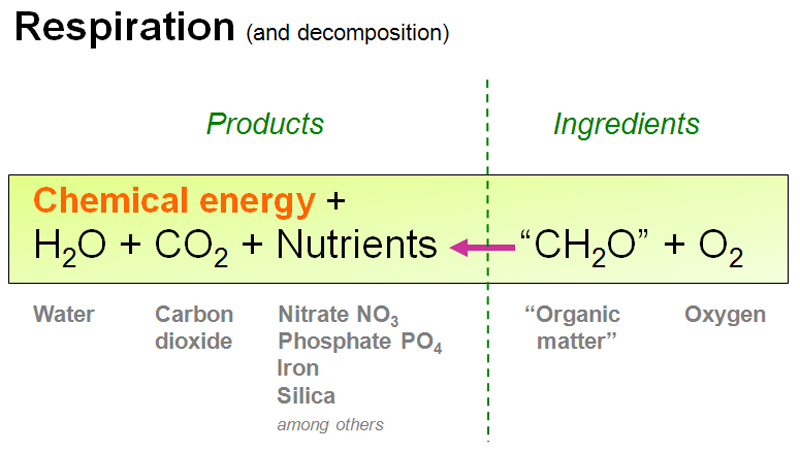

Respiration and decomposition -
The process by which heterotrophs (non-photosynthetic or chemosynthetic organisms) convert the energy in chemical subtances such as sugar into forms neede to maintain life - to build cells, transport materials through the body, maintain body temperature, move and more.
It is the opposite of photosynthesis which builds organic material and stores solar energy within it. Respiration disassembles organic matter, releases the energy stored within it and makes it available for life processes.
Respiration occurs in cells, but the process often mediated by bacteria is also the process by which living things are decomposed. Decomposition dissaembles living things back into their inroganic components and makes these basic chemical building blocks (nutrients) available for other living things.
Since respiration consumes oxygen and releases carbon dioxide (a greenhouse gas), respiration also plays a role in setting the composition of the Earth's atmosphere and thus regulating the Earth's climate.
Although fossil fuels start as organic material containing carbon, hydrogen and oxygen, fossil fuels are unusual stores of organic material that have undergone geologic alteration that removes oxgyen, and leaves carbon and hydrogen. Thus fossil fuels such as oil and gas are called hydrocarbons. Rather than being totally decomposed and low in energy concent, fossil fuels are altered and contain high energy content. It is on combustion with oxygen, in machinery and as fuel, that fossil fuels are finally decomposed and the solar energy contained within it finally released at the Earth's surface millions of years after a photosynthesizer first captured sunlight in its cells. Process that endows food (plants and animals) with the energy it contains, and endows fossil fuels, that are the chemical remains of living things, with energy.
An informal presentation of the "respiration" and "decomposition" for Earth science purposes. Please refer to biology texts for more detailed presentations. Source of equation: Memorie Yasuda.
It is the opposite of photosynthesis which builds organic material and stores solar energy within it. Respiration disassembles organic matter, releases the energy stored within it and makes it available for life processes.
Respiration occurs in cells, but the process often mediated by bacteria is also the process by which living things are decomposed. Decomposition dissaembles living things back into their inroganic components and makes these basic chemical building blocks (nutrients) available for other living things.
Since respiration consumes oxygen and releases carbon dioxide (a greenhouse gas), respiration also plays a role in setting the composition of the Earth's atmosphere and thus regulating the Earth's climate.
Although fossil fuels start as organic material containing carbon, hydrogen and oxygen, fossil fuels are unusual stores of organic material that have undergone geologic alteration that removes oxgyen, and leaves carbon and hydrogen. Thus fossil fuels such as oil and gas are called hydrocarbons. Rather than being totally decomposed and low in energy concent, fossil fuels are altered and contain high energy content. It is on combustion with oxygen, in machinery and as fuel, that fossil fuels are finally decomposed and the solar energy contained within it finally released at the Earth's surface millions of years after a photosynthesizer first captured sunlight in its cells. Process that endows food (plants and animals) with the energy it contains, and endows fossil fuels, that are the chemical remains of living things, with energy.
An informal presentation of the "respiration" and "decomposition" for Earth science purposes. Please refer to biology texts for more detailed presentations. Source of equation: Memorie Yasuda.
Questions for discussion
|
Take away concepts
|